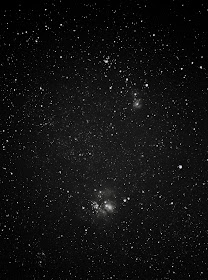 |
| Canon T5i on Orion EQ-1M, 240 subs, 46 darks, 81 bias, ISO 800, 6 sec, f/5.6, 300mm |
This stack is a total exposure time of about 24 minutes, which is by far the longest net light exposure I've ever done. You can clearly see the nebulosity in both nebulae. I also spent about 2 hours processing this image, and learned a new and better way to stretch curves in Photoshop rather than in Deep Sky Stacker. DSS is nice to get a rough approximation, but curves in Photoshop come out a lot smoother.
I also used my subtract Gaussian Blur technique for light pollution to remove the hot spot gradient in the middle of the image. It was a quick fix, but it did the job. I tried using a star mask without success, I guess I just don't understand how that works just yet - but the subtracted blur layer does a nice job removing gradient fuzz.
 |
| Canon T5i on Orion EQ-1M |
I could get 6 sec exposures without star trails, which is shorter than I got the other night on Andromeda, because the stars closer to the celestial equator appear to be moving faster than stars closer to the celestial pole.
No comments:
Post a Comment